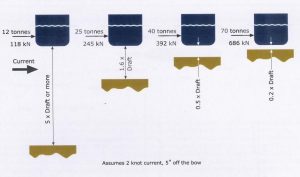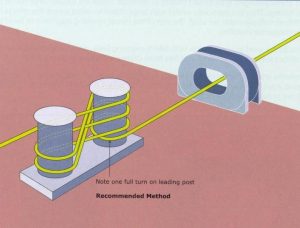This website uses cookies so that we can provide you with the best user experience possible. Cookie information is stored in your browser and performs functions such as recognising you when you return to our website and helping our team to understand which sections of the website you find most interesting and useful.
SAFE ANCHORING PROCEDURES AND MOORING BEST PRACTICE
Published: 1 December 2014
The loss prevention department have been working with Members to identify and address deficiencies and failures which have resulted from incidents and accidents involving anchoring and mooring.
Some of these have included:
- A ship’s anchor started dragging due to heavy weather, but the anchor position was not adequately monitored and the dragging was not noted for some hours. For specific guidance around preventing anchor dragging our dragging anchor page is also available.
- Anchor flukes found missing when weighing anchor after the ship had been yawing between 30 to 60 degrees in moderate to heavy weather conditions. The anchorage was in an exposed location, with a rocky sea bed
- A number of incidents where our Members’ ships either anchored too close to another ship or had another ship anchor in very close proximity, resulting in close quarters situations developing when the ships started to swing
A Root Cause Analysis (RCA) of some of the incidents has found that navigators are often not maintaining an adequate anchor watch, or even leaving the bridge unmanned for long periods whilst at anchor, either due to complacency or a lack of advice and supervision.
There are a number of reasons for a ship to anchor:
- Awaiting a berth, tide or pilot
- Cargo work
- Seeking shelter in case of cargo or ship damage
- Respite for crew under the MLC hours of rest requirements
- Lay-up
In any of the above situations, prior to a ship arriving at an anchorage, an anchor plan should be prepared which will include an assessment of all associated risks, including the following:
- The ship’s anchor system design, performance and limitations
- The designated anchorage, including the topography of the sea bed, location of pipelines and other hazards, expected weather and tidal conditions & range, and whether there is any shelter from expected weather
- The ship’s draft, freeboard/windage, under keel clearance and propeller immersion
- The depth of water and scope of cable and preferred swinging circle
- The notice period for readiness & availability of the engine
As ship sizes have increased, their anchors have also increased in weight, however this increase is not proportionate. A number of larger newer ships have consequently experienced a relatively low increase in the strength and holding power of their anchors, thereby becoming more prone to anchor loss, damage and dragging.
The International Association of Classification Societies (IACS) standards with regard to mooring, anchoring and towing are based on an assumption that the equipment required is the minimum considered necessary “..for temporary mooring of a ship within a harbour or sheltered area.
IACS also notes.. The equipment is therefore not designed to hold a ship off fully exposed coasts in rough weather or to stop a ship which is moving or drifting …The anchoring equipment presently required herewith is designed to hold a ship in good holding ground in conditions such as to avoid dragging of the anchor. In poor holding ground the holding power of the anchors will be significantly reduced”
Analysis of a number of anchoring related incidents have noted that that windlasses and brakes are generally the weakest component in any anchor system. In almost all ships windlasses tend to be modestly powered (e.g. on a standard 100,000 DWT cargo ship the anchor will be able to apply a ‘pull’ of around 34 ~35 tonnes). In theory therefore windlass performance effectively restricts anchoring to depths of no more than about 110 metres, however this would also be dependant on prevailing weather conditions and the type of sea bed.
| Anchor Type | Blue Clay | Sand / Shingle | Rock with layer of mud /sand |
| Standard Stockless | 3 to 4 x weight | 3.5 x weight | 1.8 x weight |
| HHP (AC 14) | 10 x weight | 8 x weight | 2.4 x weight |
Anchor Holding Power Test
The UK MAIB have investigated a number of anchoring related incidents and noted that the ships often found it difficult to weigh their anchor cables in wind strengths over Beaufort Force 7.
The chain stopper (guillotine) is designed to be the strongest part of the anchoring equipment and should be engaged when a ship is anchored and brought up. IACS requirements for the chain stopper state:
A chain stopper should withstand a pull of 80% of the breaking load of the anchor chain. The windlass with brakes engaged and cable lifters disengaged is to be able to withstand a pull of 45% of the breaking load of the chain.
A navigators’ responsibilities for safe navigation does not end when a ship is brought up at anchor, and it is essential that an effective anchor watch is maintained for the duration that the ship stays at anchor. Failure to do so could lead to the ship grounding, fouling submarine cables or pipelines, or alliding with another ship or structure.
If a ship is in lay-up or at anchor for a long period, it is essential that a risk assessment is carried out to decide how best the requirements for maintaining an effective anchor watch can be achieved.
In a busy anchorage, it is not uncommon to find ships anchoring or passing in close proximity to our anchored ship, and an early warning about the potential dangers can be useful to minimise any risks. Similarly, monitoring strong tidal streams or changes in prevailing weather conditions will require a further risk assessment. Early and positive action should therefore be discussed, agreed and implemented, and this will only be possible if an effective anchor watch is being maintained.
The mooring incidents we have analysed included a number of instances of mooring ropes parting and the ship drifting off the berth, however some incidents have additionally resulted in injury to personnel, invariably when safe procedures were not followed. Examples include:
- Crew by being caught in the bight of a rope coming under tension, with resultant broken limbs or death
- Limbs caught in moving or rotating mechanism
- Injuries sustained whilst attempting to free mooring lines that are jammed on the mooring drum, especially if mooring operations are still in progress
For safe mooring a summary of best practices is as follows:
- When mooring lines are under strain all personnel should remain in positions of safety i.e. out of snap back zones
- Slip and trip hazards should be indentified and highlighted
- The effect of Under Keel Clearance (UKC) and the anticipated tidal stream at the berth should be taken into consideration when deciding the mooring arrangement

- Mooring lines should be secured on bitts rather than warping drums

- If suitable leads cannot be provided for the ship’s moorings, then the master should take additional precautions, including shortening the notice period for the main engine to be available, and making provisional arrangements for tugs particularly if adverse weather conditions are expected. A note of protest should also be issued against the charterer.
- Given the number of claims relating to damage to fenders, a taking a picture of the berth and fenders just prior to berthing and just after departing can help in defending any such claim.
Presentations have also been made on safe anchoring as we have experienced a number of claims resulting from anchor losses or damages, particularly due to delays in weighing anchor in heavy weather. In an anchorage exposed to deteriorating weather conditions, a ship will usually remain safely anchored so long as there is sufficient scope on the anchor cable and the anchor is still set on the sea bed. Effective monitoring of the anchor position and verification of the ship’s position within the swinging circle is essential to obtain an early indication if the ship should begin to drag the anchor.
Once the weather starts deteriorating, a risk assessment will invariable lead to one of two choices – to stay at anchor or to weigh anchor and head for open sea.
In the former, considerations should include:
- Whether lowering more cable in the water will affect the scope of anchor cable sufficiently to ensure that the anchor flukes will remain engaged
- Whether dropping a second anchor would assist the situation
- Whether either of the above will be affected by the proximity of other ships at anchor and the availability of the requisite sea room
In the latter scenario, the prevailing weather conditions, depth of water and scope of cable will all dictate whether it will be feasible and safe to weigh anchor. The safety of the crew on the forecastle must also be considered as well as the capacity and capability of the anchoring windlass.
In either case, early and positive actions are essential, as deferring a decision in deteriorating weather conditions will only reduce the options available. It is always preferable to take action when you can rather than when you have to.
Any decision to stay, anchor or to sail should not be dictated by commercial considerations, and safety as well as practical and prudent seamanship must be paramount.

 English
English